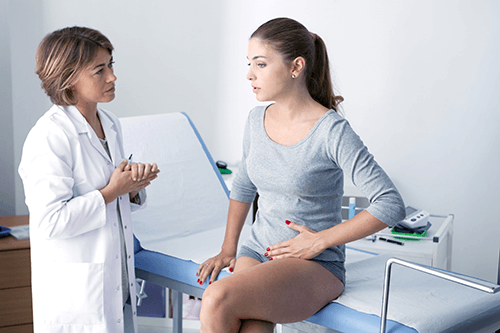Menstrual Disorders

Menstrual disorders are a disruption in physical and/or emotional symptoms just before and during a woman’s period. It can include heavy bleeding, irregular periods, missed periods and unmanageable mood swings.
Types of menstrual disorders include:
- Dysmenorrhea
- Premenstrual syndrome (PMS)
- Premenstrual dysphoric disorder (PMDD)
- Abnormal uterine bleeding
Menstrual disorders can be caused by many different conditions, including hormonal imbalances, pregnancy, infections, trauma, medications, tumors and diseases.
Causes of Menstrual Disorders
Some of the common causes of absent, infrequent, or irregular periods include:
- Uncontrolled diabetes
- Eating disorders
- Hyperthyroidism
- Hypothyroidism
- Polycystic ovary syndrome
- Endometriosis
- Antipsychotics or antiepileptic medications
Common causes of heavy or prolonged periods could include:
- Uterine fibroids
- Polyps
- Advanced liver disease
- Bleeding disorders like leukemia, von Willebrand disease, or platelet disorders
Dysmenorrhea
There are two types of dysmenorrhea, primary and secondary.
Primary Dysmenorrhea
 When women have cramps with their period it is termed primary dysmenorrhea. More than half of women who have periods experience dysmenorrhea for 1 to 2 days each month. It is the most common menstrual disorder reported.
When women have cramps with their period it is termed primary dysmenorrhea. More than half of women who have periods experience dysmenorrhea for 1 to 2 days each month. It is the most common menstrual disorder reported.
Primary dysmenorrhea is usually caused by prostaglandins naturally made by the woman’s own body in the lining of the uterus. Pain usually occurs right before a period due to the increasing level of prostaglandins. On the first day of a period, the prostaglandin levels are high. As the lining sheds from the uterus, the levels of prostaglandin and pain decrease simultaneously.
Generally, primary dysmenorrhea begins as soon as a girl starts her period or in the month’s right after. Dysmenorrhea may decrease with and age and after childbirth.
Secondary Dysmenorrhea
Secondary dysmenorrhea is caused by a disorder in the reproductive system. Disorders that can cause secondary dysmenorrhea include:
- Endometriosis
- Adenomyosis
- Fibroids
The pain of secondary dysmenorrhea is often worse than primary dysmenorrhea and tends to get worse over time. The pain may begin before a period begins and may get worse as the period continues. Unfortunately, the pain may not go away after the period ends.
Treating Dysmenorrhea
Women who are suffering with dysmenorrhea are encouraged to talk with a Rosemark gynecologist who will review medical history, symptoms and the menstrual cycle irregularity. The gynecologist will perform a pelvic exam and may order an ultrasound exam. In some cases a surgical procedure called a diagnostic laparoscopy may be necessary to examine the inside of the pelvic region.
The Rosemark gynecologist may recommend medications to see if the pain can be relieved. Certain pain relievers, called nonsteroidal anti-inflammatory drugs like Ibuprofen, may be used to address the pain. Other pain relievers or hormonal medications, such as birth control pills, may also be prescribed. These medications reduce the amount of prostaglandins manufactured by the body and lessens their effects and may make menstrual cramps less severe.
Nonsteroidal anti-inflammatory drugs work best if taken at the first sign of a period or pain and may only need to be taken for only 1 or 2 days. Women with bleeding disorders, asthma, aspirin allergy, liver damage, stomach disorders, or ulcers should not take nonsteroidal anti-inflammatory drugs.
If medications do not relieve pain, the treatment plan will change focus to finding and removing the cause of dysmenorrhea. Surgery may be necessary and in some cases, a mix of treatments works best.
Premenstrual Syndrome (PMS)
Premenstrual syndrome is a commonly used term to describe physical and psychological symptoms associated with the menstrual cycle. Up to 40% of women experience symptoms severe enough that it interrupts their lives.
One of the most common symptom is depression, but there are over 150 documented symptoms of PMS that might affect a women five to seven days before her period and disappear once her period starts or very soon after.
Some of the emotional and physical symptoms associated with PMS include:
- Bloating
- Swollen, painful breasts
- Clumsiness
- Constipation
- Fatigue
- Headaches
- Mood swings including tension, anger, anxiety, or crying
- Depression and the inability to concentrate
The rise and fall of the levels of the hormones estrogen and progesterone appear to be the cause of PMS. The rise and fall of these hormones may influence brain chemicals, including serotonin, which has a strong effect on mood.
Normal menstrual cycle symptoms differs from PMS symptoms. PMS symptoms increase in severity as the cycle progresses, are relieved when your period begins or shortly after, and are present for at least three consecutive menstrual cycles.
Premenstrual Dysphoric Disorder (PMDD)
Premenstrual dysphoric disorder is more severe than the typical PMS and women who experience symptoms say it significantly affects their lives. The percent of women who experience PMDD are approximately 3 to 8 percent of all women.
The major difference between PMS and PMDD is that of a mild tension headache with PMS and a migraine with PMDD. Other common symptoms of PMDD are:
- Increased irritability
- Anxiety
- Mood swings
The physical and emotional symptoms of PMDD are cyclical. When a woman starts her period, the symptoms should subside or end within a couple of days.
Abnormal Uterine Bleeding
Abnormal uterine bleeding may include the absence of menstrual bleeding (amenorrhea), heavy bleeding or bleeding between periods (irregular bleeding).
The absence of a menstrual period is referred to as amenorrhea. There are two kinds of amenorrhea, primary and secondary.
Primary Amenorrhea
Primary amenorrhea is the condition when a teenage girl turns 16 years of age but has not yet started her period. The disorder may be caused when the teenage girl has low body weight while participating in excessive exercise. The condition may also be a result of eating disorders or medications. Primary amenorrhea can also be caused by other circumstances, including:
- Hypothalamus disorder
- Genetic abnormalities
- Ovary irregularity
- Delayed maturity of the pituitary gland
While teenage girls may feel embarrassed to discuss primary amenorrhea symptoms, it is important for her physical and emotional well-being to seek medical attention by a gynecologist at Rosemark.
Secondary Amenorrhea
Secondary amenorrhea is diagnosed when a woman has had regular periods which suddenly stop for three or more months. Secondary amenorrhea may be caused by:
- Stress
- Weight loss
- Exercise
- Changing levels of estrogen
- Thyroid disorders
- Prolactin (a hormone that stimulates production of breast milk)
Women who have missed their period for three or more months are advised to see a gynecologist for an evaluation.
Heavy Bleeding
Heavy bleeding is diagnosed if it interferes with normal activities or if the blood loss is so heavy that a change of pad or tampon is required every hour instead of three or four times a day. Loss of blood during a normal period is about 5 tablespoons, but with a heavy period, a woman may bleed greater than 10 times.
Heavy bleeding can be caused by hormonal imbalances, medical conditions, polyps or fibroids. It is common for heavy bleeding to be caused by the production of too much or too little estrogen or progesterone. These hormones help keep a woman’s period regular.
Heavy bleeding may be attributed to the stage of life. For example, a teen may have just begun having periods. Another example could be a woman who is in her late 40s or early 50s and is getting closer to menopause.
If a woman who has reached menopause experiences heavy vaginal bleeding, they should call their Rosemark gynecologist immediately, as vaginal bleeding after menopause is not normal.
Irregular Bleeding
Irregular bleeding is also called intermenstrual bleeding, spotting, or metrorrhagia. In this situation, menstrual bleeding occurs between normal menstrual cycles. Some causes of irregular bleeding are easily treated while others are more serious. A few of these causes include:
- Stress
- Miscarriage
- Change in medication
- Hormone imbalance
- Vaginal Dryness
- A growth in the uterus or cervix
- Cancer
To identify the underlying condition, it is important to see a Rosemark gynecologist for testing, diagnosis and treatment.

